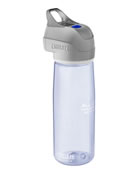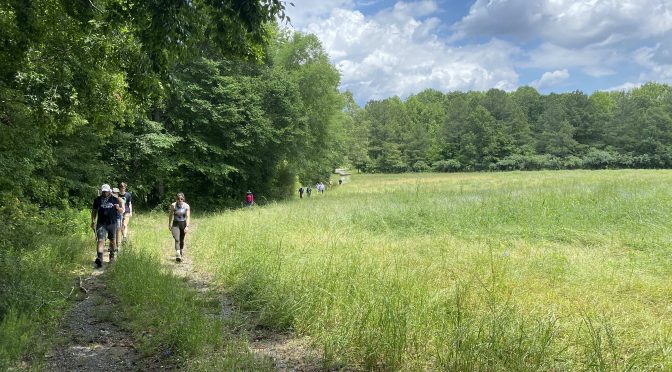Usually it’s mid-June before we’re forced to address the issue of summer heat. Before, that is, we’re forced to issue our annual plea to stay on the trail during the summer months ahead.
In some parts of the U.S. — the Northeast, the Pacific Coast, the mountain states — hikers live for the summer and its warm days. Not here, where Summer is equated with still air, sticky clothes and sweat-stung eyes.
But hold on. While some of that may be true, it’s not the full story. Approached the right way summer can be enjoyed just as much as the banner seasons of fall and spring. Just in a different way.
Some thoughts on how to embrace summer on the trail.
First, why?
You like to hike, right? So why not in summer. Here’s what keeps us from taking a summer hiatus.

The green. If you live in a lush, warm environment, you’ll want to appreciate what that means to be enveloped from forest floor to the canopy in a world rich with flora. It’s a world constantly in flux: from the blooms of elderberry, sumac and rattlesnake root in mid June, to the first tinge of fall color in the sweetgums and sourwoods, the woods are worth watching.
The critters. It’s funny how we recoil at the sight of snakes, but rejoice when we cross paths with a box turtle. The latter loves the heat and is on the move come mid-June. You’ll see those snakes out as well, while at dawn and dusk the larger local mammal populations are on the move.
The birdsong. Early morning and evening are when birds, like hikers, are at their best in the woods.
The quiet. Multiple layers of leaves, you’ll quickly discover on a summer hike, make the best insulation. I regularly hike a trail that’s within 50 yards of an interstate highway. In winter, you can’t escape the ruckus; in summer, you’ve no idea the road is there. There is one delightful exception to the quiet rule … .
The noise of night. We love staying on the trail past dark in summer because that calming quiet of the day quickly gives way to a raucous cacophony come sundown. Are those frogs? Are they crickets? And … my God, what was that? (Likely the Hitchcockian scream of a bobcat.)
Minimize the heat
Maybe you can’t ignore the heat. But you can minimize its debilitating effects.

Clothes. Wear lightweight clothes, preferably clothes that breath. Button-style fishing and hiking shirts typically have ample vents and mesh that do a good job of keeping you cool by letting you vent body heat.
Pants. If you’re not a fan of shorts, the good news is there are several relatively inexpensive lightweight nylon pants on the market. Some even come with UPF sunblock protection. The protection that long pants offer can be especially welcome in summer. If you’re on an exposed trail, that protection from the sun is great. If you’re on a trail meandering through tight vegetation, long pants are good protection from poison ivy/oak/sumac and other irritating plants, and from ticks; the little pests can still weasel their way onto your skin, but it’s a harder task.
Drink (a k a hydrate)
Water is important whenever you exercise. It’s especially important in the heat, when you’re sweating more than on a cool day. Two key points when it comes to water.
- Remember to take it. At the bare minimum, take a liter of water. Even if you’re doing a 1/2-mile nature trail, take a liter of water. If you’re going longer, say, between 2 and 5 miles, take two liters of water. If you’re going much beyond that, take two liters as well as a filtering device to get more water along the way. Note: The later only works if you are hiking in an area where the water is devoid of chemical pollution.
- Make it so you’ll want to drink it. Do you look forward to a nice, tepid glass of water, water warm enough to brew tea? Likely not. If you use water bottles, the night before a summer hike, fill the bottles 3/4 full and toss them in the freezer. In the morning, top off your ice bottle with water. If you use a hydration pack, fill the bladder with as much ice as possible, then fill with cold water.
How to dress (and undress)
Wet bandana. Soak a bandana in water, drape it around your neck. When you cross a stream, refresh the bandana. It goes a long way toward keeping your body heat regulated.
Cotton … refreshes. Normally, you’re discouraged from hiking in a cotton T-shirt. In cold, even cool weather, your T-shirt gets wet from sweat, you stop to take a break, you catch a chill. On a really hot day when you’ll only be on the trail when it’s hot, that sweat-cooled T serves as a form of air conditioning. Do be sure to have a dry T waiting for you when you get back to the trailhead.
Take extra socks. Even if you’re only hiking 4-5 miles, take an extra pair of socks. Feet get sweaty in the heat (especially if you’re wearing Gore-Tex shoes), the sweat gets absorbed into the socks. Even if you’re wearing wicking wool socks, there’s only so much wet they can wick. When socks become wet, the friction generated by your moving feet will cause blisters. Change socks before you hear an audible squish coming from your shoes.
Air out your feet on breaks. Even if you’re just taking a 5-minute snack break, sit down and liberate your feet from your shoes and socks. Drape your socks over a branch to dry, let your hot, sweaty feet have a moment to cool.
Maybe you can’t beat a spring or fall day on the trail. But summer does have something to offer.
Give it a chance.
* * *
More tips
This is an abbreviated version of our GetHiking! Guide to Summer Hiking. For the full guide, which includes information on the best times to hike and the best places to hike, go here.
Hike with us!
Can’t find anyone to hike with in the heat? You can hike with us!
- GetHiking! Wednesday Night Hikes, May 25 – July 27. One of the best times to hike in summer? In the evening, as the day begins to cool. Our 10-week series hikes every Wednesday evening from 6:30 until 8, covering 3-4 miles on a different trail each week. Learn more and sign up here.
- GetHiking! Friday Morning Hikes, June 3 – July 22. Another one of the best times to hike in summer? In the morning, before the day has a chance to heat up. Our 8-week series hikes every Friday morning at 8 a.m., covering 3-4 miles on a different trail each week. Learn more and sign up here.
- GetHiking! Summer Hike Series, June – August. Five Tuesday evening hikes and three Sunday morning hikes, all on different trails in the Triangle. Learn more and sign up here.
